2018 MITSUBISHI OUTLANDER III tow
[x] Cancel search: towPage 344 of 441
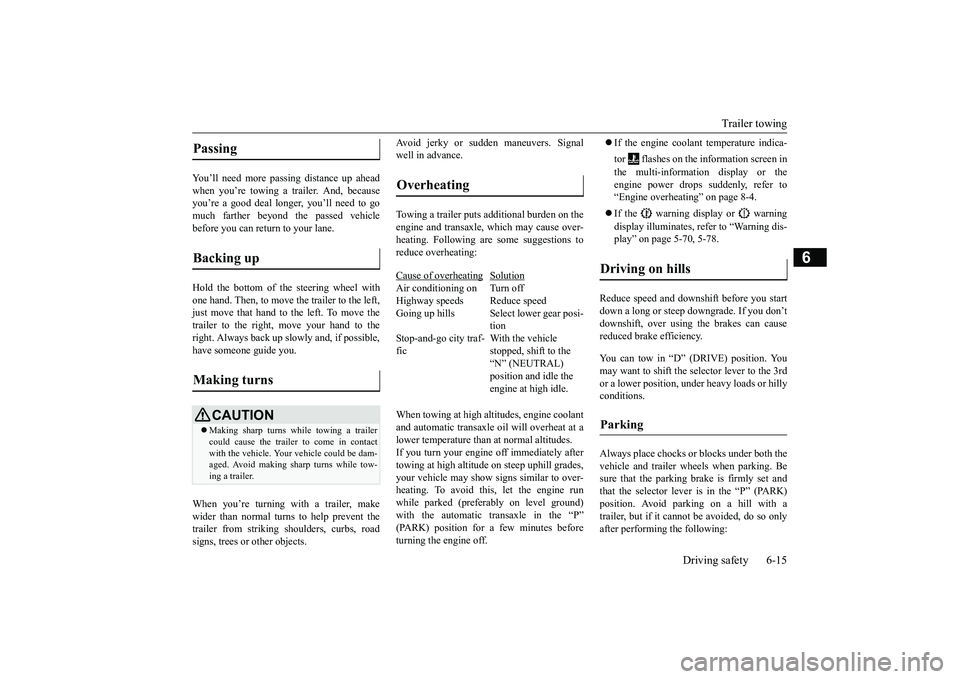
Trailer towing
Driving safety 6-15
6
You’ll need more passing distance up aheadwhen you’re towing a trailer. And, becauseyou’re a good deal longer, you’ll need to gomuch farther beyond the passed vehiclebefore you can return to your lane.Hold the bottom of the steering wheel withone hand. Then, to move the trailer to the left,just move that hand to the left. To move thetrailer to the right, move your hand to theright. Always back up sl
owly and, if possible,
have someone guide you.When you’re turning with a trailer, makewider than normal turns to help prevent thetrailer from striking shoulders, curbs, roadsigns, trees or other objects.
Avoid jerky or sudden maneuvers. Signalwell in advance.Towing a trailer puts additional burden on theengine and transaxle,
which may cause over-
heating. Following ar
e some suggestions to
reduce overheating:When towing at high al
titudes, engine coolant
and automatic transaxle oil will overheat at alower temperature than at normal altitudes.If you turn your engine off immediately aftertowing at high altitude
on steep uphill grades,
your vehicle may show
signs similar to over-
heating. To avoid this
, let the engine run
while parked (preferably on level ground)with the automatic transaxle in the “P”turning the engine off.
If the engine coolant temperature indica-tor flashes on the information screen inthe multi-information display or theengine power drops suddenly, refer to“Engine overheati
ng” on page 8-4.
If the warning display or warningdisplay illuminates, re
fer to “Warning dis-
play” on page 5-70, 5-78.
Reduce speed and downshift before you startdown a long or steep downgrade. If you don’tdownshift, over using the brakes can causereduced brake efficiency.You can tow in “D” (DRIVE) position. Youmay want to shift the selector lever to the 3rdor a lower position, under heavy loads or hillyconditions.Always place chocks or blocks under both thevehicle and trailer wheels when parking. Besure that the parking brake is firmly set andthat the selector lever is in the “P” (PARK)position. Avoid parki
ng on a hill with a
trailer, but if it cannot be avoided, do so onlyafter performing the following:
Passing Backing up Making turns
CAUTIONMaking sharp turns while towing a trailercould cause the
trailer to come in contact
with the vehicle. Your
vehicle could be dam-
aged. Avoid making sharp turns while tow-ing a trailer.
Overheating Cause of overheating
Solution
Air conditioning on Turn offHighway speeds Reduce speedGoing up hills Select lower gear posi-
tion
Stop-and-go city traf-fic
With the vehicle stopped, shift to the “N” (NEUTRAL) position and idle the engine at high idle.
Driving on hills Parking
BK0249100US.book 15 ページ 2017年5月10日 水曜日 午前8時49分
Page 345 of 441
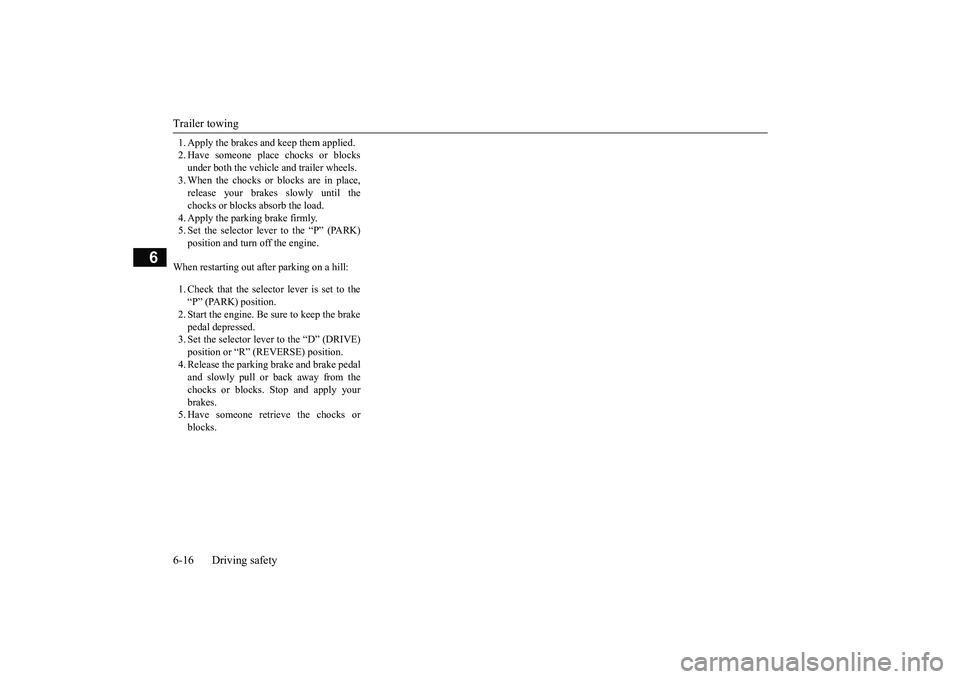
Trailer towing6-16 Driving safety
6
1. Apply the brakes a
nd keep them applied.
2. Have someone plac
e chocks or blocks
under both the vehicle and trailer wheels.3. When the chocks or blocks are in place,release your brakes slowly until thechocks or blocks absorb the load.4. Apply the parking brake firmly.5. Set the selector lever to the
Page 358 of 441
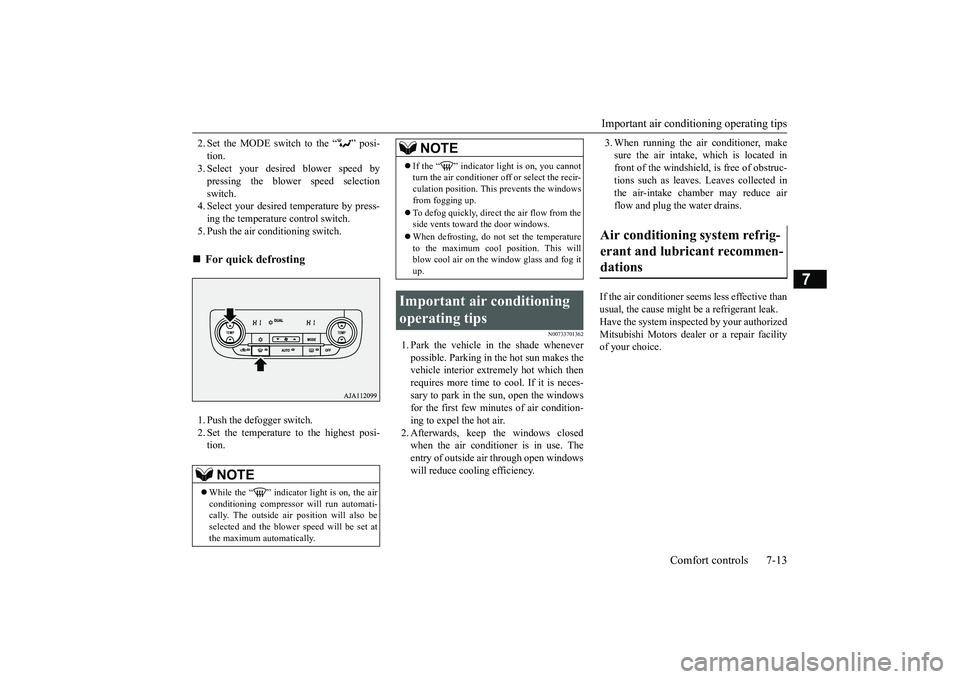
Important air conditioning operating tips
Comfort controls 7-13
7
2. Set the MODE switch to the “ ” posi-tion.3. Select your desire
d blower speed by
pressing the blower speed selectionswitch.4. Select your desired temperature by press-ing the temperature control switch.5. Push the air conditioning switch.1. Push the defogger switch.2. Set the temperature to the highest posi-tion.
N00733701362
1. Park the vehicle in the shade wheneverpossible. Parking in the hot sun makes thevehicle interior extremely hot which thenrequires more time to cool. If it is neces-sary to park in the sun, open the windowsfor the first few minutes of air condition-ing to expel the hot air.2. Afterwards, keep the windows closedwhen the air conditioner is in use. Theentry of outside air through open windowswill reduce cooling efficiency.
3. When running the air conditioner, makesure the air intake, which is located infront of the windshield,
is free of obstruc-
tions such as leaves. Leaves collected inthe air-intake chamber may reduce airflow and plug the water drains.
If the air conditioner seems less effective thanusual, the cause might be a refrigerant leak.Have the system inspected by your authorizedMitsubishi Motors dealer or a repair facilityof your choice.
For quick defrosting NOTE
While the “ ” indicator light is on, the airconditioning compressor
will run automati-
cally. The outside air
position will also be
selected and the blower
speed will be set at
the maximum automatically.
If the “ ” indicator light is on, you cannotturn the air conditioner
off or select the recir-
culation position. This prevents the windowsfrom fogging up.To defog quickly, direct the air flow from theside vents toward the door windows.When defrosting, do not set the temperatureto the maximum cool position. This willblow cool air on the
window glass and fog it
up.
Important air conditioning operating tips
NOTE
Air conditioning system refrig-erant and lubricant recommen-dations
BK0249100US.book 13 ページ 2017年5月10日 水曜日 午前8時49分
Page 362 of 441
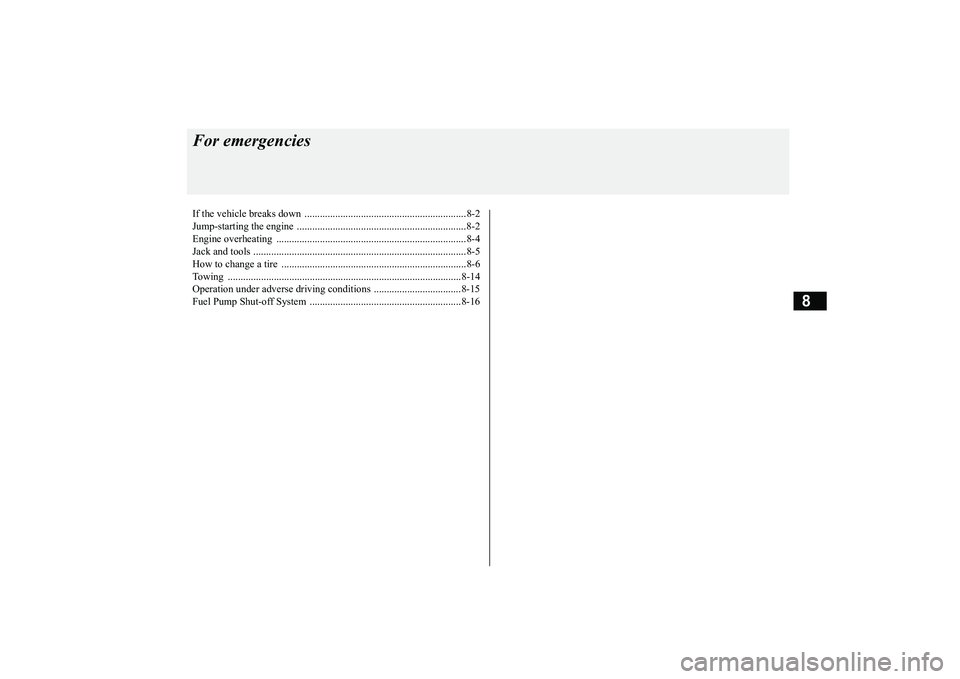
8
For emergenciesIf the vehicle breaks down ...............................................................8-2Jump-starting the engine ..................................................................8-2Engine overheating ..........................................................................8-4Jack and tools ...................................................................................8-5How to change a tire ........................................................................8-6Towing ...........................................................................................8-14Operation under adverse driving conditions
...........
.........
.........
.....8-15
Fuel Pump Shut-off System ...........................................................8-16
BK0249100US.book 1 ページ 2017年5月10日 水曜日 午前8時49分
Page 363 of 441
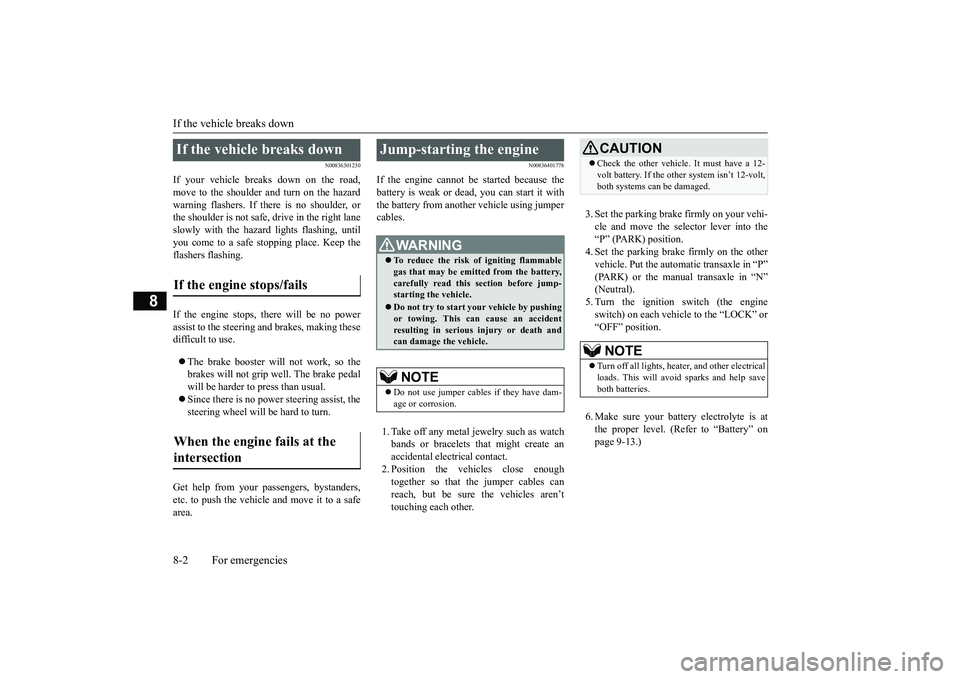
If the vehicle breaks down8-2 For emergencies
8
N00836301230
If your vehicle breaks down on the road,move to the shoulder and turn on the hazardwarning flashers. If there is no shoulder, orthe shoulder is not safe, drive in the right laneslowly with the hazard
lights flashing, until
you come to a safe stopping place. Keep theflashers flashing.If the engine stops, there will be no powerassist to the steering and brakes, making thesedifficult to use.The brake booster will not work, so thebrakes will not grip well. The brake pedalwill be harder to press than usual.Since there is no power steering assist, thesteering wheel will be hard to turn.
Get help from your passengers, bystanders,etc. to push the vehicle
and move it to a safe
area.
N00836401778
If the engine cannot be started because thebattery is weak or de
ad, you can start it with
the battery from anothe
r vehicle using jumper
cables.1. Take off any metal jewelry such as watchbands or bracelets th
at might create an
accidental electrical contact.2. Position the vehi
cles close enough
together so that the jumper cables canreach, but be sure the vehicles aren’ttouching each other.
3. Set the parking brake firmly on your vehi-cle and move the selector lever into the“P” (PARK) position.4. Set the parking brake firmly on the othervehicle. Put the automatic transaxle in “P”5. Turn the ignition switch (the engineswitch) on each vehicle to the “LOCK” or“OFF” position.6. Make sure your battery electrolyte is atthe proper level. (Refer to “Battery” onpage 9-13.)
If the vehicle breaks down If the engine stops/fails When the engine fails at the intersection
Jump-starting the engine
WA R N I N GTo reduce the risk of igniting flammablegas that may be emitted from the battery,carefully read this section before jump-starting the vehicle.Do not try to start you
r vehicle by pushing
or towing. This can cause an accidentresulting in serious
injury or death and
can damage the vehicle.NOTE
Do not use jumper cables if they have dam-age or corrosion.
CAUTIONCheck the other vehicle.
It must have a 12-
volt battery. If the other system isn’t 12-volt,both systems can be damaged.NOTE
Turn off all lights, heat
er, and othe
r electrical
loads. This will avoid sparks and help saveboth batteries.
BK0249100US.book 2 ページ 2017年5月10日 水曜日 午前8時49分
Page 366 of 441
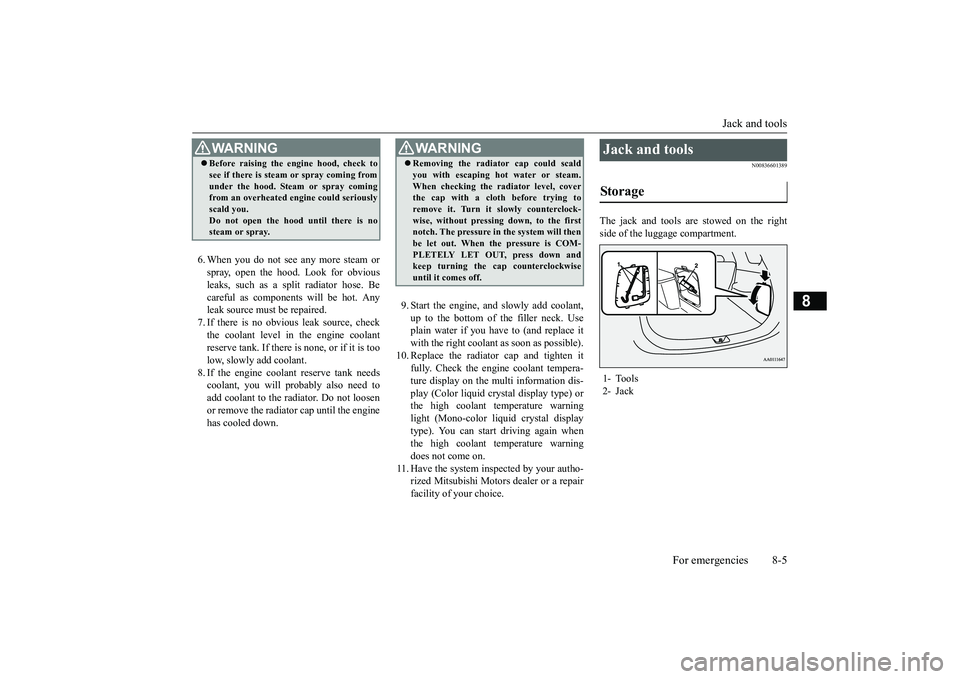
Jack and tools
For emergencies 8-5
8
6. When you do not see any more steam orspray, open the hood. Look for obviousleaks, such as a split radiator hose. Becareful as components will be hot. Anyleak source must be repaired.7. If there is no obvious leak source, checkthe coolant level in the engine coolantreserve tank. If there is
none, or if it is too
low, slowly add coolant.8. If the engine coolant reserve tank needscoolant, you will probably also need toadd coolant to the radiator. Do not loosenor remove the radiator cap until the enginehas cooled down.
9. Start the engine, a
nd slowly add coolant,
up to the bottom of the filler neck. Useplain water if you have to (and replace itwith the right coolant as soon as possible).
10. Replace the radiator cap and tighten it
fully. Check the engine coolant tempera-ture display on the mu
lti information dis-
play (Color liquid crystal display type) orthe high coolant temperature warninglight (Mono-color liqui
d crystal display
type). You can start driving again whenthe high coolant temperature warningdoes not come on.
11. Have the system inspected by your autho-
rized Mitsubishi Motors
dealer or a repair
facility of your choice.
N00836601389
The jack and tools are stowed on the rightside of the luggage compartment.
WA R N I N GBefore raising the en
gine hood, check to
see if there is steam or spray coming fromunder the hood. Steam or spray comingfrom an overheated en
gine could seriously
scald you.Do not open the hood until there is nosteam or spray.
WA R N I N GRemoving the radiat
or cap could scald
you with escaping hot water or steam.When checking the radiator level, coverthe cap with a cloth before trying toremove it. Turn it slowly counterclock-wise, without pressing down, to the firstnotch. The pressure in the system will thenbe let out. When the pressure is COM-PLETELY LET OUT, press down andkeep turning the cap counterclockwiseuntil it comes off.
Jack and tools Storage 1- Tools2- Jack
BK0249100US.book 5 ページ 2017年5月10日 水曜日 午前8時49分
Page 368 of 441
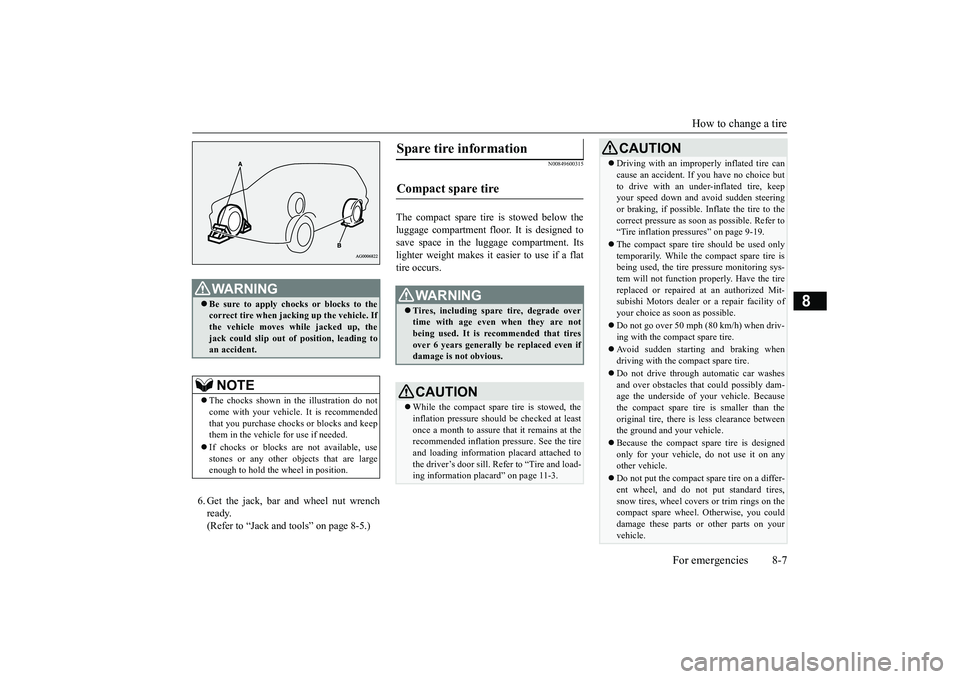
How to change a tire
For emergencies 8-7
8
6. Get the jack, bar and wheel nut wrenchready.(Refer to “Jack and t
ools” on page 8-5.)
N00849600315
The compact spare tire is stowed below theluggage compartment fl
oor. It is designed to
save space in the luggage compartment. Itslighter weight makes it easier to use if a flattire occurs.
WA R N I N GBe sure to apply choc
ks or blocks to the
correct tire when jacking up the vehicle. Ifthe vehicle moves while jacked up, thejack could slip out of
position, leading to
an accident.NOTE
The chocks shown in the illustration do notcome with your vehicl
e. It is recommended
that you purchase chocks or blocks and keepthem in the vehicle for use if needed.If chocks or blocks
are not available, use
stones or any other obj
ects that are large
enough to hold the wheel in position.
Spare tire information Compact spare tire
WA R N I N GTires, including spar
e tire, degrade over
time with age even when they are notbeing used. It is recommended that tiresover 6 years generally
be replaced even if
damage is not obvious.CAUTIONWhile the compact spare tire is stowed, theinflation pressure shoul
d be checked at least
once a month to assure that it remains at therecommended inflation pressure. See the tireand loading informati
on placard attached to
the driver’s door sill. Refer to “Tire and load-ing information placard” on page 11-3.
Driving with an imprope
rly inflated tire can
cause an accident. If
you have no choice but
to drive with an under-inflated tire, keepyour speed down and avoid sudden steeringor braking, if possible. Inflate the tire to thecorrect pressure as s
oon as possible. Refer to
“Tire inflation pressures” on page 9-19.The compact spare tire should be used onlytemporarily. While the compact spare tire isbeing used, the tire pr
essure monitoring sys-
tem will not function pr
operly. Have the tire
replaced or repaired at an authorized Mit-subishi Motors dealer or
a repair facility of
your choice as soon as possible.Do not go over 50 mph (80 km/h) when driv-ing with the compact spare tire.Avoid sudden starting and braking whendriving with the compact spare tire.Do not drive through automatic car washesand over obstacles that
could possibly dam-
age the underside of your vehicle. Becausethe compact spare tire is smaller than theoriginal tire, there is less clearance betweenthe ground and your vehicle.Because the compact spare tire is designedonly for your vehicle, do not use it on anyother vehicle.Do not put the compact spare tire on a differ-ent wheel, and do not put standard tires,snow tires, wheel covers
or trim rings on the
compact spare wheel. Otherwise, you coulddamage these parts or other parts on yourvehicle.CAUTION
BK0249100US.book 7 ページ 2017年5月10日 水曜日 午前8時49分
Page 375 of 441
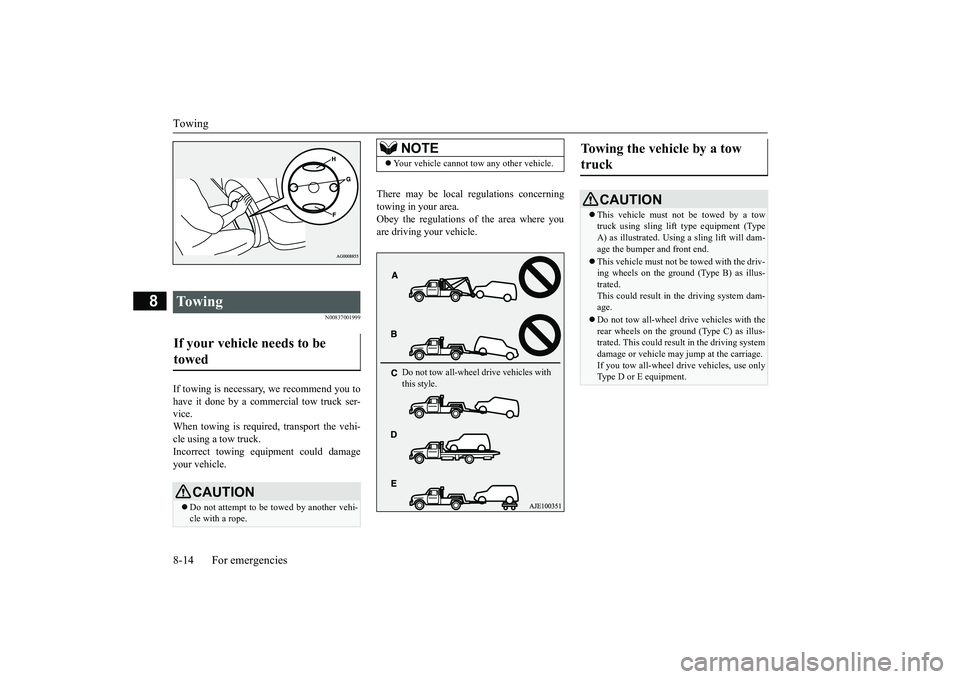
Towing8-14 For emergencies
8
N00837001999
If towing is necessary,
we recommend you to
have it done by a commercial tow truck ser-vice.When towing is required, transport the vehi-cle using a tow truck.Incorrect towing equipment could damageyour vehicle.
There may be local re
gulations concerning
towing in your area.Obey the regulations of the area where youare driving your vehicle.
To w i n g If your vehicle needs to be towed
CAUTIONDo not attempt to be
towed by another vehi-
cle with a rope.
NOTE
Your vehicle cannot to
w any other vehicle.
Do not tow all-wheel drive vehicles with this style.
Towing the vehicle by a tow truck
CAUTIONThis vehicle must not be towed by a towtruck using sling lift
type equipment (Type
A) as illustrated. Usi
ng a sling lift will dam-
age the bumper and front end.This vehicle must not be towed with the driv-ing wheels on the ground (Type B) as illus-trated.This could result in the driving system dam-age.Do not tow all-wheel drive vehicles with therear wheels on the ground (Type C) as illus-trated. This could result in the driving systemdamage or vehicle may
jump at the carriage.
If you tow all-wheel driv
e vehicles, use only
Type D or E equipment.
BK0249100US.book 14 ページ 2017年5月10日 水曜日 午前8時49分